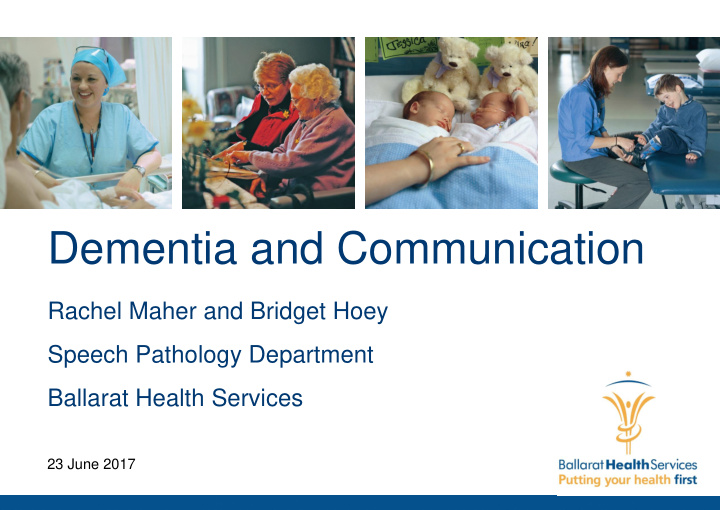



Dementia and Communication Rachel Maher and Bridget Hoey Speech Pathology Department Ballarat Health Services 23 June 2017
Speech Pathology at BHS • Team of 17 Speech Pathologists (SPs). • Provide services to children and adults who have communication and/or swallowing disorders. • SP service provided in all programs of BHS, including the acute, sub-acute, residential and community programs.
Communication and the Language System. • Language system located in left hemisphere of brain. • Several specialised centres for language in the brain including Broca’s area, Wernicke’s area and the angular gyrus. • In people with dementia, breakdown in the language system occurs. (Fischbach 1992, Raichle 1992, as cited in Reese, 2000)
Speech Pathology Australia (SPA) video: Communication Matters. • Video: https://www.youtube.com/watch?v=2WPyp2wNZ08 (Speech Pathology Australia, 2014)
Benefits of good communication skills. • An ability to communicate enables people with dementia to: - Maintain a sense of identity; - Continue to take part in their own care, through having an ability to give and receive information; - Relieve loneliness, and express fear and anxiety; - Become a good communication partner for others; - Increase cognitive stimulation for people with dementia. (Lubinski, 1995, as cited in Reese, 2000)
Strategies to facilitate communication: Comprehension techniques. • Use names not pronouns . • Use concrete vocabulary • Short, simple sentences • Active, not passive voice • State the topic of conversation . (Reese, 2000)
Strategies to facilitate communication: Expression techniques. • Say it in a different way . • Y/N or either/or questions • Allow processing time • Topic reminders • Relevant questions • Reminisce! . (Reese, 2000)
Strategies to facilitate communication: Non-verbal techniques. • Expression • Facial expressions • Body language (position and orientation) • Gesture • Touch . (Santo Pietro & Ostuni, 1997, as cited in Reese, 2000)
Strategies to facilitate communication: Environmental techniques. • Visual factors • e.g. Glare, reflections, insufficient light, uneven light, insufficient visual contrast, and visual clutter • Auditory factors • e.g. Hearing loss and impact of background noise • Tactile / Olfactory factors • e.g. Objects to touch, objects with aromas (Reese, 2000)
Facilitating Communication: MESSAGE • M – M aximise attention • E – E xpression and body language • S – S upport the conversation • S • A – A ssist with visual A ids • G – G et their message • E – E ncourage and E ngage in communication (Smith et al., 2011)
The University of Queensland video: MESSAGE Communication in Dementia • Video: https://www.youtube.com/watch?v=cdA-yUuz_g8 (University of Queensland Dementia Care, 2012)
Facilitating Communication: MESSAGE Debbie maximised Stanley’s attention by sitting at eye -level and maintaining eye contact throughout the conversation. Debbie demonstrated interest through her voice and gestures. Debbie used scarf as visual aid to help orient Stanley to the topic. Debbie chose a topic familiar to Stanley and showed knowledge of his interests. Debbie accepted all of Stanley’s contributions as meaningful. Debbie encouraged Stanley to continue participating by giving him extra time and reflecting what he said back. Debbie supported understanding by repeating questions. (University of Queensland Dementia Care, 2012)
The University of Queensland video: MESSAGE Communication in Dementia • Video: https://www.youtube.com/watch?v=cdA-yUuz_g8 (University of Queensland Dementia Care, 2012)
Not Facilitating Communication: MESSAGE Katrina moved around while speaking to Stanley. Katrina asked open questions (e.g. “What have you eaten today?”), which can be more difficult to answer. Katrina drew attention to Stanley’s memory problem. Katrina repeatedly asked Stanley questions that he found difficult to answer. Katrina used the term “darling” repeatedly, which could be interpreted as talking down to Stanley. Overall, Katrina didn’t pay attention to Stanley’s verbal and non-verbal communication. (University of Queensland Dementia Care, 2012)
So… Communication matters! (Alzheimer’s Australia, 2017) (The Aged Care Standards and Accreditation Agency Ltd, 2004)
SP Role: Swallowing Function • Swallowing process ensures that oral nutrition is able to be received adequately and safely. • Phases of swallowing: - Anticipatory phase - Oral phase - Pharyngeal phase - Oesophageal phase (Logemann, 1998)
Dementia and Swallowing Function • Physiological changes related to dementia that may impact on feeding and swallowing include: - Reduced tongue movement; - Delayed pharyngeal phase; - Reduced movement of larynx; - Decreased sensation of smell, taste and touch. • As a result of dementia, there are also a number of behavioural changes that may occur, which can impact on the mealtime experience. (Logemann, 1998)
When to refer to SP • Symptoms of oropharyngeal dysphagia include: - Spillage of food/fluid out of the mouth; - Difficulty chewing; - Food residue in mouth after swallowing; - Holding food in mouth; - Delay in starting the swallowing reflex; - Coughing, throat clearing and/or wet voice during/after meals; - Choking incidents. • Refer to SP for swallowing assessment if concerned. (Logemann, 1998)
Thank you. Ballarat Health Service Speech Pathology Department Phone: 5320 3955
References • Alzheimer’s Australia. (2017). Managing Changes in Communication. Retrieved from https://www.fightdementia.org.au/national/support-and-services/carers/managing-changes-in-communication Logemann, J. A. (1998). Evaluation and Treatment of Swallowing Disorders . (2 nd Ed.). Austin, Texas: PRO- • ED. • Reese, P. B. (2000). The Source for Alzheimer’s & Dementia. East Moline, IL: LinguaSystems. • Smith, E. R., Broughton, M., Baker, R., Pachana, N. A., Angwin, A. J., Humphreys, M. S., Mitchell, L., Byrne, G.J., Copland, D.A., Gallois, C., Hegney, D. and Chenery, H. J. (2011). Memory and communication support in dementia: Research-based strategies for caregivers. International Psychogeriatrics, 23 (2), 256-263. • Speech Pathology Australia. (2014, August 28). Communication Matters [Video file]. Retrieved from https://www.youtube.com/watch?v=2WPyp2wNZ08 • The Aged Care Standards and Accreditation Agency Ltd. (2004). Demystifying Dementia Care – Module 2: Communicating in Dementia Care. [Workshop booklet]. • University of Queensland Dementia Care. (2012, March 1). MESSAGE Communication in Dementia: Teaching Examples for Care Staff [Video file]. Retrieved from https://www.youtube.com/watch?v=cdA- yUuz_g8
Recommend
More recommend